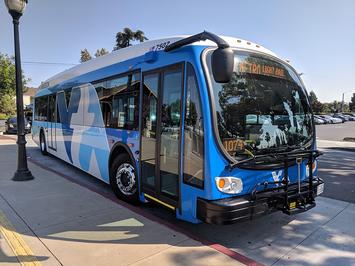
The Antiplanner has often called San Jose’s Valley Transit Authority (VTA) the nation’s worst transit agency (with some competition from DC Metro). It would be nice, however, to confirm that with hard data. The question is what are the best ways to measure agency performance?
A previous comparison of transit agencies used 23 different measures of performance. Some of these were outputs, such as trips per capita and farebox recovery. Most, however, were inputs, such as revenue miles, expenses per capita, and vehicle miles between failures. But inputs are not a sound measure of performance; an agency can spend a lot of money but carry few riders; it can run a lot of vehicle miles, but if they don’t go where people want to go, they are not serving the public well; it can lots of breakdowns, but if people are still riding it, it must be doing something good.
So I want to focus on outputs, and I’ve tentatively identified four:
1. Percentage of seats filled;
2. Trips per capita;
3. Fares as a percent of costs; and
4. Change in riders since 2014.
Percentage of seats filled should be obvious. The Port Authority of New York and New Jersey fills 87 percent of the seats on its trans-Hudson trains. New York’s MTA fills about 64 percent. Transit agencies in Honolulu, Los Angeles, and Portland fill 40 to 50 percent of their seats. But agencies in Charlotte, Cleveland, Orlando, Sacramento, and San Antonio only fill 20 to 25 percent of seats. San Jose’s VTA is 26 percent. Low passenger counts means agencies are providing too much service or service that goes to the wrong places.
Trips per capita is an important input but presents a problem. Many urban areas have multiple agencies, and an agency may make a valid contribution to the area even though it carries only a fraction of the region’s riders. For example, Chicago transit carries 68 trips per capita, but the region’s Metra commuter trains carry only 10. One answer is to use an average of each agency’s per capita trips and the regional trips per capita.
Among major urban areas, per capita trips range from 10 (in Detroit) to 223 (New York). Among major transit agencies, per capita trips range from 3 (New York Department of Transportation) to 403 (New York MTA). Outside of New York, the highest are San Francisco Muni (159) and Chicago Transit Authority (149). Calculations of agency trips per capita are based on what each agency says is the population it serves in its reports to the FTA while urban area trips per capita are based on the Census Bureau’s 2017 urban area population estimates.
Fares as a percent of costs uses a combination of both inputs (costs) and outputs. Even though I want to focus on outputs, I think this is more useful than just, say, fares per ride or fares per capita. Transit agencies that spend a lot of money tell elected officials and voters that they are doing so to attract more riders. But if the riders aren’t willing to pay a significant share of those costs, they must not find the transit services worthwhile.
The last measure asks how resilient the transit system is. Ride hailing emerged as a competitive threat to transit in 2014. Since then, the Greater Cleveland Regional Transit Authority and Broward County Transit hav lost nearly 30 percent of their riders while the Port Authority of Allegheny County (which serves Pittsburgh) lost less than 1 percent and, of course, a few agencies have gained riders. Agencies that have provided the most response transit service are likely to lose the least riders to ride hailing.
Applying these four criteria to the transit agencies that carry more than 20 million riders a year, the nation’s worst managed transit agency is (drumroll please) — the Charlotte Area Transit System (CATS). VTA is fifth-worst, with Sacramento, Cleveland, and St. Louis coming between them.
Eight of the nation’s ten best agencies are in New York, while the other two are in San Francisco. The best is New York’s MTA. While MTA benefits from New York’s high per-capita ridership, it also scored well on the other three measures.
Since I don’t feel completely comfortable with the per-capita ridership measure, I also calculated scores using only the other three measures. While this results in minor changes to the exact ranking, the best and worst agencies are still roughly the same. Cleveland has the lowest score, followed by St. Louis, but Sacramento, Charlotte, and San Jose are still among the bottom five. The Port Authority is best, MTA is third best, while the biggest change is that Seattle’s Sound Transit jumped from fourteenth to third best.
I can live with that result, considering that Seattle’s transit is growing due to downtown jobs, not light-rail construction. It would still be nice to include some measure of ridership in the calculation. Either way, though CATS’ low score was something of a surprise, the numbers seem to confirm my initial impressions.
I welcome your comments and suggestions. I’d be particularly interested in a better way of dealing with the per capita ridership issue.
This piece originally appeared on The Antiplanner.
Randal O’Toole is the director of the Independence Institute’s Transportation Policy Center and author of the recent book, Romance of the Rails: Why the Passenger Trains We Love Are Not the Transportation We Need.
Photo credit: mliu92 from San Mateo [CC BY-SA 2.0], via Wikimedia Commons












